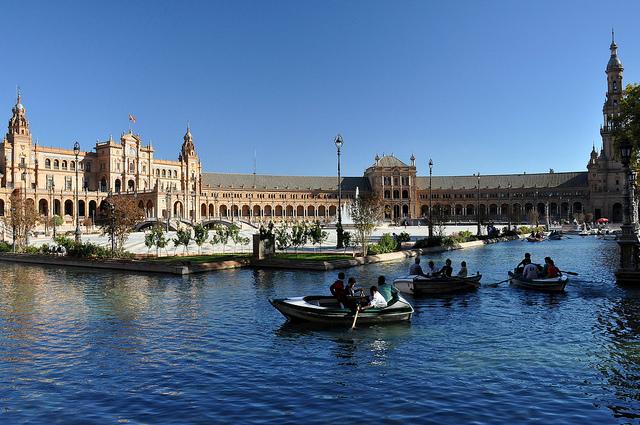The region Andalusia is located in the south of
Spain and ranges to the most southern point of Europe, the rocks of Gibraltar. During pre-Christian times the territory of Andalusia was the kingdom Tartessos. In the following centuries Phoenicians, Moors and Arabs shaped the culture of Andalusia. Today the region is an attractive holiday destination due to its rich history and numerous seaside resorts. Very popular for summer vacations is the Costa des Sol. Favourite destinations for day trips are Malaga, famous for its wine and raisins, and the city of Granada, where the fortress Alhambra can be discovered. An El Dorado for surfers is the windy Costa de la Luz.
Seville – The cultural center of Andalusia
No trip to Andalusia without visiting the city of Seville. The town is famous for its towers, the narrow streets, playful fountains and wide places. Over hundred churches show the deep religious belief of the habitants. Andalusia is the home of the Flamenco. Have a look at the Flamenco House in Seville and learn everything about this emotional dance. A culinary specialty of Andalusia are Tapas. In Seville you find them in a number of different variations which are all worth trying. Throughout the year there are all kind of fiestas and events in Andalusia, like religious processions on Easter, the “Sonnenfest” in
Marbella or the people’s fair in Seville.
The Alhambra in Granada
The most popular sight in Spain is the Alhambra in Granada, built in the 13th century. The Alhambra is Moorish architecture in its most beautiful form. The town castle got its name from the red coloured walls. A must-see are the Nasrid Palaces with stunning gardens and the private chambers of the lords. Inside of the building you find impressive mosaics and the Lion’s Well. Generalife, the summer palace, is located right next to the fortress wall and is famous for its sparkling fountains. The city wall is called Alcabaza and leads through to the district Albaicín.
Alcázar
The Alcázar in Seville is a royal palace, originally built for Peter I. It is one of the most significant Christian buildings that are influenced by Moorish style. Today the royal family still uses Alcázar as their accommodation when they are in Andalusia. You definitely should have a look at the ambassador hall with its wooden ceiling. Islamic decoration dominates the room. However, the garden grounds should not be overlooked either. You find a stunning mixture of English, French and Arab elements there.
Mezquita
In the town of Córdoba the most important attraction is the Mezquita, a former mosque that is used as a cathedral today. With an impressive size of 23,000 square meters it is the third largest mosque in the world. Existing for 1000 years now, the Mezquita is a witness of touching history. 856 artistic columns show the different styles of the specific ages. Impressive pieces can also be found in the treasure chamber, built in the 15th century. There you should pay particular attention to the liturgical device garnished with gold and precious stone.
The Roman bridge of Córdoba
The impressive 200-metre-long Roman bridge is another important sight in the Andalusian town of Córdoba. Sixteen arches in total strung together over the river Guadalquivir. It is assumed that the bridge was built during the leadership of the Roman Emperor Augustus after the battle of Munda 45 before Christ. The bridge was once part of the Via Augusta, the longest street in Hispania. Right in the middle of the bridge you find the statue of the Archangel Raphael, constructed in the 17th century.
Picasso Museum
In the town center of Malaga and only a few meters away from Picasso’s birthplace, you find the Museo Picasso. Over 200 artworks created by the Spanish painter during different periods are displayed in the museum, for example ceramics, sculptures and paintings. The style of the building combines classical elements of Andalusian architecture with modern construction. Temporary special exhibitions give an insight into the touching life of Pablo Picasso.
Plaza de España
Visiting Seville there is no way getting around the Plaza de España. The 50,000 square-meter place was usually made for the Ibero-American Exhibition in 1928. It is fenced by a 515-meter-long canal with four bridges as symbols for the Spanish kingdoms. The building you see at Plaza de España is an historic statement as well. The tile ornaments symbolize the 48 provinces of Spain. It’s not surprising that the Plaza de España has already been a popular venue for several movies, like “Lawrence of Arabia” and “Star Wars”.
Cathedral of Granada
The Cathedral of Granada is the greatest existing gothic building and the third largest cathedral in the world after St.Peter’s Basilica in Rome and St.Paul’s Cathedral in London. The construction work has started in the year 1401 after demolishing the central mosque of the Arabic period of occupation. Do not miss to climb the steps up to the Giralda, the former minaret and now bell tower of the cathedral. From here you can enjoy a stunning view of Seville. Another tourist magnet is the sarcophagus of Christoph Kolumbus, carried by four herolds.
 © Scott Anderson / Flickr [CC BY-ND 2.0]
© Scott Anderson / Flickr [CC BY-ND 2.0]